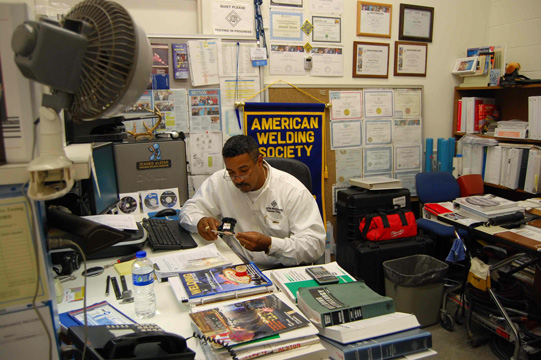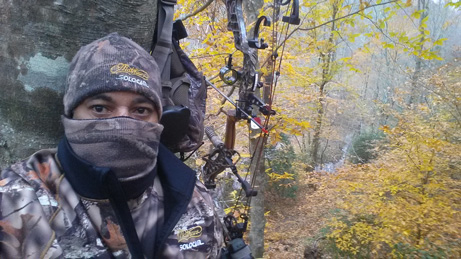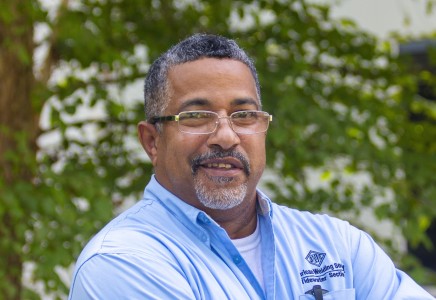Welding Program Manager Hits His Target, Trains Next Generation
Just as the old saying goes, Jenord Alston “eats his elephants one bite at a time”… at least that is how he describes his approach to undertaking huge tasks. As the welding program manager at Jefferson Lab, Alston has spent decades piling up qualifications and certifications he needs to ensure he can tackle whatever welding project or unique welding requirement arises in the lab’s unique environment, which requires providing not only one-of-a-kind apparatus for advanced R&D, but also equipment with strict specifications for basic research.
Due to his hard work and dedication to his field, Alston has become the American Welding Society’s Tidewater Section Chairman, an AWS Certified Welding Inspector, an AWS Certified Welding Educator, an American Petroleum Institute-Authorized Piping Inspector, and an API-authorized Vessel Inspector. He has also earned several American Society for Non-Destructive Testing Level-II certification and a host of AWS endorsements.
Since joining Jefferson Lab in 2001, Alston says his largest elephant was preparing for the API570 qualification exam, which, he says, had a two-foot tall stack of guides as study material.
“It was an eight-hour test,” he says. “I studied until 11 p.m. at night and all day on Saturdays for four months. Anything less, and I don’t think I could have done it. When I looked back, I saw elephant bones. Everything after that is a cake walk.”
Volunteering to teach skills for life
Alston recognizes that being able to weld is a skill that can change a person’s entire life and outlook. For that reason, he volunteers to help train the next generation of welders through several organizations. Locally, Alston volunteers to teach young people welding skills through Boy Scouts of America, where he teaches essential skills that scouts need to earn their welding merit badges.
Due to his involvement on advisory boards for the local welding schools and with his work with the AWS Tidewater Section, Alston was invited to participat e in the ORPHANetwork’s Puerto Cabezas Welding Program in Nicaragua. For one week a year, he taught potential welding trainers how to weld and then how to teach orphans the trade.
e in the ORPHANetwork’s Puerto Cabezas Welding Program in Nicaragua. For one week a year, he taught potential welding trainers how to weld and then how to teach orphans the trade.
“I took my first trip to Nicaragua in October 2014,” Alston says. “That first trip was to give everyone that wanted the opportunity to try welding a chance. The mission was to find several people that I could come back to train as future trainers.”
Using his vacation time from the lab, Alston returned to Nicaragua two more times.
“The second time I went, I spent a week training the trainers that would eventually be the welders responsible for training the orphans. Then, the third time I went, I certified the trainers to be certified welders so they could begin training the orphans. It’s possible that they are the only certified welders in the country.”
Alston feels confident that his work with the welder training program has given dozens of orphans opportunities for a brighter future.
“In my mind, the program has done and will continue to do what I expected it to do: give a kid a good chance at earning a living and having a chance at a good life.”
Training and inspecting for safety and longevity’s sake
Back at home, Alston maintains the welding examiner programs for the lab, serves as a welding consultant to the Jefferson Lab engineers and designers and inspects Jefferson Lab’s welding projects—both at the lab and at vendor locations—throughout various project development stages. Already, he is working with the engineers and designers to develop welder specifications for projects that are slated to be built years from now.
“It’s very important that all processes be checked along the way, before we put anything into our system,” he explains. “If I don’t do my job well, an incorrectly manufactured part could get put into our facility that could injure or kill someone. Also, we may expect a machine to last 20 years and, if we cut corners, it can go bad in five, and we can’t have that.”
Alston says it’s essential that he train workers to be meticulous and thorough.
“Everybody in the chain is working towards the same goal: to ensure that everything is built safe and to the code specifications,” he explains. “And I’m the last line of defense against a weld-related mistake that could cause a major problem.”
What happens if Alston detects a problem with a weld?
“We have a process to stop the welding here at the lab, and if there’s a problem with a part we’ve ordered, that process is to send the work back until it’s done safely and correctly and with the proper accompanying documentation,” he explains.
 Meticulousness in the field
Meticulousness in the field
Alston applies the same focus and preparation to his hobby of bow hunting deer.
“Anyone can shoot with a gun,” he explains. “To hunt with a bow, you have to first have the skill to get close to a deer and then put a shot on him that will kill it— not just wound it. So, well before I climb in my tree stand to shoot a deer, I will shoot 1,000 times into my target to ensure that when I draw back to shoot, I’m accurate.”
Alston explains that he spends a lot of time just practicing with a target in his back yard and on some private land he owns in preparation for deer season, so that when the time comes to take the shot, he’s ready.
Whether he is spending his free time volunteering, working at the lab or bow hunting, Alston’s approach is the same.
“I’m out there because it’s difficult. The day that it gets easy, I will put it down and find something else to do.”
By Carrie Rogers


